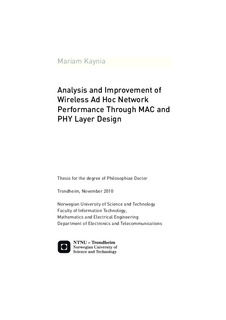| dc.contributor.author | Kaynia, Mariam | nb_NO |
| dc.date.accessioned | 2014-12-19T13:46:17Z | |
| dc.date.accessioned | 2015-12-22T11:44:47Z | |
| dc.date.available | 2014-12-19T13:46:17Z | |
| dc.date.available | 2015-12-22T11:44:47Z | |
| dc.date.created | 2011-02-02 | nb_NO |
| dc.date.issued | 2010 | nb_NO |
| dc.identifier | 394202 | nb_NO |
| dc.identifier.isbn | 978-82-471-2442-0 (printed ver.) | nb_NO |
| dc.identifier.isbn | 978-82-471-2443-7 (electronic ver.) | |
| dc.identifier.uri | http://hdl.handle.net/11250/2370139 | |
| dc.description.abstract | In this dissertation, we investigate the performance of point-to-point wireless ad hoc networks. The performance evaluation is performed in terms of outage probability, which is defined as the probability of receiving messages correctly. This metric is stochastic, and closely related to the ubiquitous notions of throughput and transmission capacity. In order to make the analysis tractable, we establish a proper analytical framework, and make reasonable approximations in the derivations.
Approaching the design of ad hoc networks through the medium access control (MAC) layer, analytical expressions are obtained for the outage probability of a given mobile ad hoc network in an unbounded (infinite) region. We consider the following MAC protocols: slotted and unslotted ALOHA, carrier sensing multiple access (CSMA) with transmitter sensing, and CSMA with receiver sensing. Moreover, we investigate the impact of various ad hoc network characteristics on the outage probability. In particular, we add fading to the path loss channel model and measure the degradation it causes; we bound the network domain to investigate the edge effects; and we introduce fading within a bounded network. In each case, new outage probability expressions are derived.
Having established a fundamental understanding of the behavior of various flavors of mobile ad hoc networks, we propose MAC layer techniques to improve the performance. Three schemes are proposed: 1) optimization of the sensing threshold in CSMA, 2) addition of a feedback channel between each transmitter and its receiver for improving the decision making stage of CSMA, and 3) introduction of bandwidth partitioning. In each scenario, new outage probability expressions are derived both in nonfading and fading networks.
Finally, we step into the domain of multiple input multiple output (MIMO) communications, allowing for multiple antennas at transmitters and receivers. Within an ad hoc setting with no channel state information (CSI) at the transmitters, lower and upper bounds are derived on the outage probability and ergodic capacity. In the particular case of multiple input single output (MISO) channels, different transmission schemes are proposed in order to achieve the best usage of transmit antennas. With the addition of CSI at the transmitters, we consider various interference management schemes, with focus on the high SNR regime. We propose a binary power control scheme that ensures an increase in the sum rate of the MIMO network with many users, and that operates in a distributed manner, regardless of the interference management algorithm applied. | nb_NO |
| dc.language | eng | nb_NO |
| dc.publisher | Norges teknisk-naturvitenskapelige universitet, Fakultet for informasjonsteknologi, matematikk og elektroteknikk, Institutt for elektronikk og telekommunikasjon | nb_NO |
| dc.relation.ispartofseries | Doktoravhandlinger ved NTNU, 1503-8181 | nb_NO |
| dc.title | Analysis and Improvement of Wireless Ad Hoc Network Performance Through MAC and PHY Layer Design | nb_NO |
| dc.type | Doctoral thesis | nb_NO |
| dc.contributor.department | Norges teknisk-naturvitenskapelige universitet, Fakultet for informasjonsteknologi, matematikk og elektroteknikk, Institutt for elektronikk og telekommunikasjon | nb_NO |
| dc.description.degree | PhD i elektronikk og telekommunikasjon | nb_NO |
| dc.description.degree | PhD in Electronics and Telecommunication | |
